Stuart Jaffe's Blog, page 11
February 7, 2012
Guest Post: Gail Z. Martin
Another Guest Post today to celebrate the release of Gail's newest book. I've known Gail for many years now and though she lives just a hop and a skip away, I tend only to see her on the con circuit. That's the way it is with a lot of writers. Weird. Anyway, Gail writes wonderful epic fantasy adventures and she's being gracious enough to spend a little time here with us today. Take it away, Gail!
The End of the World As We Know It
My newest book, The Dread: Book Two in The Fallen Kings Cycle, [image error]confronts a medieval world on the brink of a "War of Unmaking." Plague, famine, civilian unrest, pretenders to the throne, usurpers, traitors and a foreign invasion—along with betrayals large and small—have set the monarchies of the Winter Kingdoms on a collision course with war. The stakes are huge, and no matter who wins and who loses, neither the kingdoms nor the main characters will ever be the same.
Sure, I drew on ancient Asian, Sumerian, and Celtic/Norse mythology, as well as my own fevered imagination to conjure up this war-torn world, but I'm certain that the angst in modern headlines had some subconscious influence over the decision to set in motion a cataclysm that changes the course of history.
I also blame some of it on my undergraduate training as a historian, taught by professors who saw flashpoints in history more as a confluence of trends rather than the handiwork of a single "great man." Where a single individual rises to such prominence as to seem capable of personally changing history, I've been taught to look deeper, to see the societal, religious, financial, cultural and other shifts that made it possible for the "great man" to come to the fore and achieve such prominence.
Personally, I find this a more interesting reading of history than seeing an endless procession of heroes and villains who are larger than life. And as an author, I think that the idea that those who become heroes and villains stand astride the crest of a great flow of other circumstances makes a story much more intriguing as well. While my characters always have choices, both they and the readers should feel that other forces are pressing toward particular options, or making other choices unsatisfactory. Sometimes, the hero chooses to swim against the tide. In other situations, he (or she) rides the swell, realizing how little control they have over the rushing torrent, trying to make the best of it. Throw magic, active deities, and two groups of immortal enemies into the equation, and all bets are off.
Part of the fun for me with epic fantasy is having a big enough canvas to set up this kind of cataclysm and bring the reader along for the ride. The story that begins in The Sworn: Book One of the Fallen Kings Cycle, finds its conclusion in The Dread, but those who have been with me for all four preceding Chronicles of the Necromancer books will find old loose ends tied up and unfinished business brought to a close.
So is this the end of adventures in the world of the Winter Kingdoms? No. But my surviving characters do deserve a little rest! So while the survivors rebuild, I'll be bringing out a brand new series, The Ascendant Kingdoms Saga, from Orbit in 2013. Time to start the mayhem all over again!
You can find The Dread in stores and online everywhere. For more about my books, please visit www.ChroniclesOfTheNecromancer.com, and like me on Facebook.com/WinterKingdoms. I blog at DisquietingVisions.com, host author interviews at GhostInTheMachinePodcast.com, and tweet @GailZMartin.
January 31, 2012
The Big Influencer — Stagecoach
No big spoiler here, but there is a pretty big chase scene in The Way of the Sword and Gun, and aside from being a whole heckuva lotta fun to write, the scene is a great example of how other media can influence a writer's work. A few people, especially those who have heard me pitch The Malja Chronicles as "Xena meets Mad Max," might logically conclude that the big chase scene is heavily influenced by the big gas truck chase in The Road Warrior. And they would be both 100% right and 100% wrong.
See, that phenomenal bit of SF movie action is wonderful (and still holds pretty well today) and without a doubt, inspired the idea for the big chase in my book. However, the scene in the Mad Max movie is itself inspired by another film, one that I happen to watch not knowing the connection. That movie is Stagecoach.
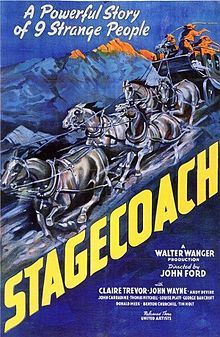 Stagecoach is an old, black & white western starring John Wayne and directed by the incomparable John Ford. One evening during the planning stage of The Way of the Sword and Gun, I decided to watch this film. I have always been a big Clint Eastwood western fan and never cared much for John Wayne, but I also never gave John Wayne that much of a try. Couple that with the fact that the movie Stagecoach is referred to as one of the all-time greats by many living all-time greats (such as Steven Spielberg, Martin Scorsese, and Francis Ford Coppola), I figured I should check it out.
Stagecoach is an old, black & white western starring John Wayne and directed by the incomparable John Ford. One evening during the planning stage of The Way of the Sword and Gun, I decided to watch this film. I have always been a big Clint Eastwood western fan and never cared much for John Wayne, but I also never gave John Wayne that much of a try. Couple that with the fact that the movie Stagecoach is referred to as one of the all-time greats by many living all-time greats (such as Steven Spielberg, Martin Scorsese, and Francis Ford Coppola), I figured I should check it out.
And what do I find?
There's a crucial, exciting, and huge chase scene. While watching it, I recognized this movie as the source material not only of The Road Warrior, but just about any big action chase scene. It made me rethink my little chase scene, look closer at the rhythm of the scene, and add elements that I think turned the whole piece into an exciting, action-packed experience.
Besides revealing some source material here, I wanted to bring this up because it illustrates the way multiple influences can layer atop each other. In this case, The Road Warrior and Stagecoach. But those are only the ones I'm conscious of in this regard. Considering the far-reaching influence Stagecoach has had on film-makers and storytellers, I wouldn't be surprised if my scene enjoyed deeper connections that I'm not entirely aware of on the conscious level.
Point is — even when we know why we do things in the work we create, we don't always know.
January 24, 2012
Guest Post: David B. Coe
Since this blog is all about influences on writing, and since I have developed numerous writer friends over the years, I figured why not put the two together? So, this first guest post on the subject of influences comes from one of my best writer friends and a fantastic epic fantasy author, David B. Coe. He's been in this game for a long time and has plenty of wonderful thoughts on the subject. He also blogs about writing and writing business over at Magical Words. Take it away, David:
 What influences us when we write? What external factors shape our characters, our settings, our narratives? When Stuart approached me about guest blogging on the subject, my initial thought was that I have no idea what shapes my thinking on any particular book or story.
What influences us when we write? What external factors shape our characters, our settings, our narratives? When Stuart approached me about guest blogging on the subject, my initial thought was that I have no idea what shapes my thinking on any particular book or story.
But the more I think about my recent novels, the more I realize that my work is very much a product of social and political trends I see in today's world.
When I started Rules of Ascension, the first book in my Winds of the Forelands quintet, I had in mind to write a series that entertained with magic and political scheming and romance, while also delving into issues of race and prejudice. I studied history, and had long been interested in racial history and ethnic identity. But I was also looking to write a book with cool magic in it. And, after spending a couple of weeks visiting Wales and exploring the ruins of castles at Caernarfon, Beaumaris, and Conwy, I knew that I wanted to write something with lots of castle intrigue.
That is the book I thought I was writing with Rules — something fun, filled with dukes and castle sieges and spells. But I wrote that book in 2000 and 2001, and had just started work on Seeds of Betrayal, the second book in the sequence, when the 9/11 attacks occurred.
Without planning it, in a way without even realizing it, I allowed the 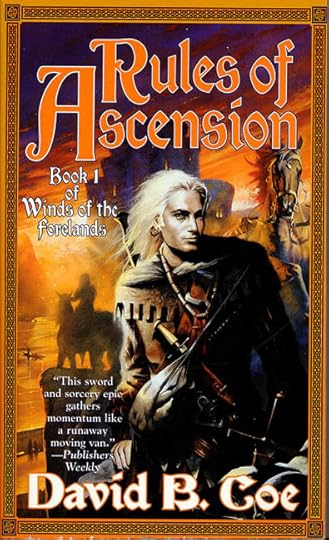 aftermath of 9/11 to shape the rest of that series as well as the three volumes of the Blood of the Southlands, which were a follow-up to the Forelands books. I don't want to give away too much of the plotting, but it's enough to say that on one side of the racial divide were people who tried to navigate the waters between acquiescing in their own victimization and giving in to violent extremism. At the same time, the other side vacillated between tolerance of those who differed from them and cruel repression rooted in irrational paranoia.
aftermath of 9/11 to shape the rest of that series as well as the three volumes of the Blood of the Southlands, which were a follow-up to the Forelands books. I don't want to give away too much of the plotting, but it's enough to say that on one side of the racial divide were people who tried to navigate the waters between acquiescing in their own victimization and giving in to violent extremism. At the same time, the other side vacillated between tolerance of those who differed from them and cruel repression rooted in irrational paranoia.
Of course, all of this happens within the context of magic and a quasi-medieval political system. It is quite possible to read the five Forelands books and the three Southlands books without ever seeing in the narrative a post-9/11 parable. On the other hand, if you're looking for it, it's certainly there.
And I want to say again that it was not something I planned. The events of 2001-2003 influenced profoundly the writing I did in that period, but it really wasn't until I was concluding the fourth book that I became fully aware of that influence. Most of it crept in, fed by my subconscious, by the yin-yang of my own emotions: my concerns for the safety and security of my family, my friends, my country, and, simultaneously, my disgust with the jingoistic rhetoric driving policy makers on both sides of the aisle in Washington.
I am a historian as well as a writer. I have used works of fiction, as well as other art forms, as source material for historical research. I know as well as anyone that it is nearly impossible for an author — or an artist of any other sort — to step completely out of his or her time when creating. All literature is, to some degree, a product of the climate in which it was written. Sometimes those contemporary influences are quite obvious — think of Huckleberry Finn, Uncle Tom's Cabin, 1984. At other times, the influences are far more subtle; Lord of the Rings comes to mind.
But though I know as a historian to consider these factors when reading books and stories from another era, I have to admit that it is odd to see my own fiction shaped by the history around me, particularly since I was largely oblivious of that influence as it was being exerted. We are, all of us, products of our culture, our society, and, yes, the history to which we bear witness. My books bear the marks of other novels I have read, of movies and plays I have seen, of music I listened to while writing. And the most important novels I have published thus far in my career also carry within them reminders of the most searing, tragic event our nation has experienced in the last half century. I suppose the most surprising thing about this is that it took me so long to recognize the impact of that day on the work that came after.
January 17, 2012
The Ultimate Influence on Writers
This blog is mostly about influences on my writing. So I talk about the Blues and anime and movies and tough characters and all that kind of stuff. But something I don't talk about often is the other major influence on my writing, the most important influence any writer has — Life.
My life, like any life that's lasted forty years or so, has had plenty of crazy twists and turns. Amazing people have come in and out of my life. Some people I would love to cross paths with again — for good times remembered and for apologies I still owe. Others I'm happy to never set eyes on — some of these out of anger, some out of shame.
And all those relationships, some that lasted years and some that lasted only a day, they all blend into me, they shape me, and as a result, they are my writing. More than skill, more than hard work, these people and the experiences I had with them make my writing unique. This is the real thing that separates one writer from another. This is why a novel by Stuart Jaffe is uniquely different from one by Stephen King. He and I have a lifetime's worth of different relationships that formed who we are and how we see the world. When we think of stories and sit down to write them, the details we pick out, the words we choose to express ourselves, the motivations we give our characters, even the plot devices we employ, are all filtered through the lives we've lived. That's what really makes the difference.
Writing itself is a skill that can be learned from practice. But the rest of it is truly created from one's life.
Think about Henry Miller for a moment. Tropic of Cancer could never have been written by, say, Ernest Hemingway. The two men led such different lives (though they probably both consumed equal amounts of alcohol), knew such vastly different people, and so, neither could ever have come up with the story of the other. Henry Miller trying to write Hills Like White Elephants would be a travesty. Heck, Miller couldn't conceive of such a story let alone write it. He'd be more interested in what led to those two having sex and the act itself rather than the aftermath. And Hemingway trying to write Tropic of Cancer? For all his bluster, he'd never be able to do more than hint (in some sparse but poignant declarative sentences) at the physical nature of those relationships.
Why? Because both men went in and out of different relationships that shaped them. And I don't mean just romantic relationships. I'm talking family, friendships, even a work relationship — the type of boss a person has or co-workers.
Every single person we encounter, every moment we breathe, we change who we are. It is the reason the books I write today are utterly foreign when compared to my writing from a decade ago. Life has changed me, and so it has changed my writing. This is the ultimate influence on our writing, the one that we can never escape.
January 11, 2012
The Way of the Sword and Gun RELEASED!
That's right, folks! The ebook edition of The Way of the Sword and Gun (Book 2 of The Malja Chronicles) is officially out. You can get it at Amazon, B&N, Smashwords, and elsewhere for only $4.95. The print edition is in the final stages and should be out in a few weeks and will be $11.99.
I'm saying it a lot this week, but it's important for readers to know — we writers survive on being a known entity. The #1 way people learn about new authors is via word-of-mouth. In other words, you fine folks! So, if you like The Malja Chronicles or anything I've written and want more, you can do a few things to help out (and this applies to any author you want to support, not just me):
1) Obviously, buy one of my books!
2) Tell other people about my books — especially those who you know would like what I write.
3) Leave a review on Amazon, Like my FB page, and all the other usual social media stuff.
These little acts add up and help people discover new authors. Y'know, authors like me.
And if you're uncomfortable doing #2 or #3, no worries. I'm always happy for you to simply buy a book and enjoy it. In fact, that's the most important part of all.
January 3, 2012
The Way of the Sword and Gun — The Blurb
Last week, I showed you the new cover. This week, I give you the back cover copy (which in e-book circles has taken over the term "blurb"):
For the past year, Malja and her companions have traveled the ruined lands of Corlin trying to bring order to the chaos of a world destroyed by magic. But when Owl, a warrior skilled in the Way of the Sword and Gun, enlists their aid in facing a new threat from the North, everything changes.
Now, Malja must face Queen Salia — a self-made ruler obsessed with taming the wild magical energies pulsing from a place known as the Library. Magical energies that could drive her mad and destroy the world once again.
But magic this powerful can do more than destroy. It could also help Malja unlock a path toward the desires she buries in her heart. Desires that may tear her from those she cares for the most.
December 23, 2011
The Way of the Sword and Gun — Cover Revealed!
Here it is, folks! The cover of book 2 –
This guy's name is Owl, and he's going to be quite a handful for Malja.
Book release is coming in January!
December 20, 2011
The Influence of Lone Wolf and Cub
A big part of this blog is centered around discussing the various influences on my work. When it comes to The Way of the Black Beast, without a doubt, one the largest influences came from the Japanese samurai "manga" series Lone Wolf and Cub. I put the word manga in quotes because the series isn't drawn in a typical manga style. It's far more mature looking — more so than any manga or American comic book/graphic novel I can think of. And rightfully so, since the story is very mature.
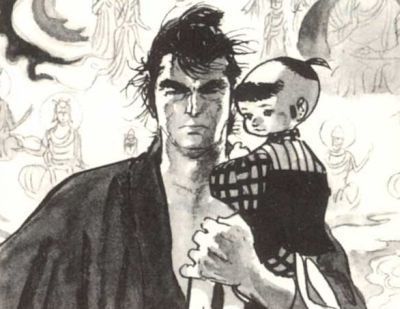 Lone Wolf and Cub follows a ronin on his quest of vengeance. In order to achieve his goal, he needs money — a lot of money. And so when we meet him, he is a sword for hire. With him, is his little boy who has taken to the violent life entirely too easily and too well.
Lone Wolf and Cub follows a ronin on his quest of vengeance. In order to achieve his goal, he needs money — a lot of money. And so when we meet him, he is a sword for hire. With him, is his little boy who has taken to the violent life entirely too easily and too well.
Their adventures, compiled into a lovely 28 volume set by Dark Horse Comics, are fascinating, action-packed, and touching. Through these two traveling swords, we get a view of medieval Japan that includes the underbelly and ugliness alongside the pageantry and gracefulness. As well, we are giving the story of a strong bond between father and son, one based on blood ties but also on the trust and reliance of brother-soldiers.
Despite all the action (and there's a lot of action), to me Lone Wolf and Cub is a quiet story. There is a layer of the tale that takes place during the long walks through the Japanese countryside. That time when Lone Wolf and his son are alone and only have their thoughts to fill the void.
Those moments helped me shape the world I created for Malja and Tommy. Like medieval Japan, the country of Corlin is violent. But just like Japan, Corlin is large enough to have plenty of quiet, open spaces. In some ways, writing those moments, the time between the big action sequences, proved to be both the hardest and the most rewarding. It's those moments, when we watch Malja deal with the consequences of the violence she creates, that we see into her true character.
I've read through the entire sequence of Lone Wolf and Cub three times and I intend to go through it more. It's part of the research I do when preparing a Malja story. I continually find little nuggets that send my mind off in exciting directions. And as the release of The Way of the Sword and Gun nears, I know I'll soon be working on the third Malja book. There are numerous things that influence me and these stories, but no other weighs in so heavily on Malja as this incredible tale. While you wait for me to get the next book out, take some time to look into Lone Wolf.
December 13, 2011
Movies We Loved (Just Might Not Admit It): Heavy Metal
Heavy Metal magazine began in 1977 and continues to this day. It is essentially a short story anthology for the comic book crowd, but not just any short story. Heavy Metal has always specialized in subversive comics of high-action fantasy and science fiction. These can be subversive on numerous levels including story and character as well as the art style itself. There tends to be a lot of nudity and violence as well as more base humor. The magazine also published a lot of Conan the Barbarian stories which j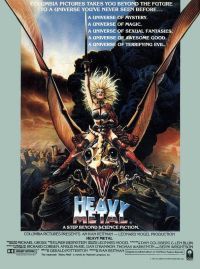 ust made it all that more awesome when I was a teenager.
ust made it all that more awesome when I was a teenager.
In 1981, some people got together and thought, we should make a movie out of this magazine and get some rock bands to contribute songs. Lucky for us, everyone in that room was high as a kite and they all agreed. I strongly doubt an R-rated animated movie of this kind could be made today. Then again, Team America was made but I think the only reason that got off the ground was because the South Park people were behind it.
Anyway, what makes Heavy Metal a film worth watching is that it is so strange and risky. They take chances. There's sex and drugs and violence. There's lowlife friendship and an honest portrayal of greed and lust. Some of the risks pay off, some are gratuitous (though less so than is often found in the magazine), and some fall flat. Doesn't matter to me, though. I've always loved this film because it dared to do these things.
In writing (and all art forms), we pay a lot of lip service to ignoring the market, to taking the risks, to making the "art" the way we want to do it. That type of noise has gotten louder in the publishing world because of the rise in indie publishing. But here's the thing. Most don't do it. Most want to put out a second book or a third or more. Most fear what would happen if they really took those risks.
The movie Heavy Metal could have played it safe. They could have done a watered-down version of the magazine and maybe had a big hit. Instead, they took a successful cult magazine and turned it into a successful cult movie. They didn't worry about whether or not there would be Heavy Metal 2 (there was, as well as a few off-shoots, but not until 2000 with the appropriately named, Heavy Metal 2000). They simply put out the art they wanted and let the chips fall.
Obviously it wasn't as pure as all that — they were out to make a buck. And yet, they still managed to make artistic choices over financial ones.
Whenever I feel down about writing and contemplate playing it safe, there are a few places I go to get re-inspired to take chances. Without a doubt, Heavy Metal is one of those sacred places.
Besides, where else can you find two coke-head aliens saving the world?
December 6, 2011
Women Kickin Butt — Vin
Having finished the Mistborn trilogy earlier this year, I figured Vin would be a perfect character to include in this blog post series. The Mistborn trilogy (although now there's a fourth book, so it's a trilogy only in the Douglas Adams sense) was written by the talented author, Brandon Sanderson, and begins centuries after the world fell to the evil dark baddie. A rag-tag group of thieves and con-artists get together in what becomes part-heist and part-revolution story. At the center of it all is Vin, an orphan girl living on the hard streets who learns that she is a "Mistborn" — a person who can use all the magic powers available to people (whereas those who have magic powers, generally only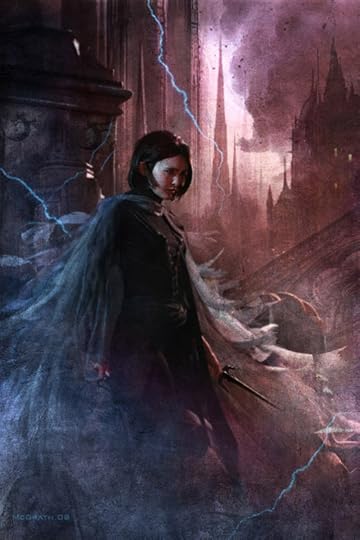 have one).
have one).
Vin's story-arc is wonderful to experience. In some ways, she follows the classic monomyth idea of a child of low-birth rising to the top. Indeed, by the end of the trilogy, she has become a Queen, of sorts, and more beyond that. However, in the first novel, appropriately titled Mistborn, it is her "fish out of water" storyline that appeals most.
Yes, she kicks a lot of butt in some of the most exciting and intricate battles involving magic that I've ever read. But she also must pose as a member of the wealthy class, attending balls and dealing with petty, and not-so-petty, societal intrigues. Her ability to navigate these fights is just as impressive as her physical fighting skills.
And, on top of it all, she even finds time to fall in love.
Not that this becomes a mushy love story. After all, this post series is about strong female characters, not the swooning damsel in distress. But that doesn't mean there can't be love. Vin's relationships, however, are not ones of the Me-Tarzan/You-Jane dichotomy. Rather Vin meets others (especially in the romantic elements) as an equal — strong in ways her counterparts are not, weak in ways they are strong. Like any healthy relationship, the two people strengthen each other, and that is ultimately what Vin learns. It's a hard road for her, though, mainly do to her harsh upbringing.
And that's another aspect of how Sanderson writes such a great character. He makes much use of Vin's emotional scars. Growing up on the streets has messed her up plenty when it comes to trust issues, for example. Taking a person like that and throwing her into a con-game in which she falls in love is a recipe for disaster.
It's also a recipe for a great read of a great, butt-kicking heroine.



